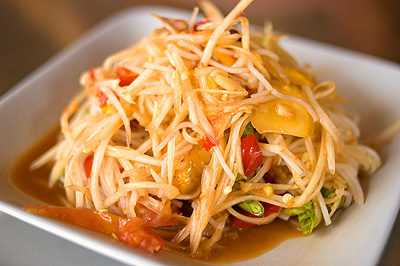appetite, August-September 2006
Pok, pok pok! This sound, the unmistakable hollow thud of unripe papaya being pounded in a clay mortar, is a rallying call for Thailand’s favorite dish, som tam. Unlike other foods where a delicious odor or artful presentation is the impetus to dig in, the advertising technique of the som tam vendor is a bell-like ring, which for many has become associated with this spicy snack.
Som tam, a salad of strips of crispy green papaya, has its origins in the rural kitchens of northeastern Thailand. The recipe is a probably recent one, as the many of the main ingredients (papaya, tomatoes, chilies, limes) were first brought to Thailand from South America in the 16th century. Nonetheless, the dish spread quickly and can now be found in virtually every city in Thailand, and is by all accounts the de facto national dish. In a country with such a diversity of food, what is it about this particular invention that makes it so popular?
One explanation is that som tam successfully combines all four of the essential flavours of Thai cooking: hot, sour, salty and sweet. In this case the hot comes from the liberal use of fresh chilies, the sour from a squeeze of lime juice, the salty from fish sauce, and the sweet from palm sugar. Another reason for its popularity is that the dish is a nearly perfect snack food, its intense spiciness providing a mental “full” while at the same time still being relatively light. Thus som tam can and is consumed between meals on street corners and in office buildings, a fiery fix to hold one over until the next meal.
Som tam can be neatly divided into two schools. The isaan or northeastern Thai style is considered by many to be the “real” som tam, and features hearty strips of papaya pounded up with chilies and a thick, unfiltered fish sauce known as plaa raa. The salad is typically bulked out with ingredients ranging from preserved freshwater crabs to ma kok, a tart fruit. The other type of som tam is a more modern take favored by city dwellers that revolves around fine threads of crispy papaya dressed with bottled fish sauce, tomatoes, green beans, roasted peanuts and dried shrimp. This version tends to emphasize sweet and sour flavors, and is generally eaten as a snack. Regardless of the style, som tam is always made to order, and the degree of spiciness or tartness is determined by the customer.
Despite its popularity, som tam is still largely relegated to the streets, and in a case of reverse discrimination, som tam vendors are almost exclusively female. The dish is made by first bruising the more resilient ingredients, a few small cloves of garlic, the pasty palm sugar, and a generous handful of tiny fresh chilies. Next, a handful of shredded green papaya is added and the mixture is given a few strong thumps before adding a splash of fish sauce and a squeeze of fresh lime or tamarind pulp. At this point the som tam is simultaneously mixed and pounded, often using a spoon along with the wooden pestle in an effort to combine the flavours thoroughly.
As a reminder of its northeastern origins, som tam is typically served with sticky rice, the staple grain of this part of the country, as well as a side dish of raw vegetables and herbs typically including Thai basil, sliced cucumber and strips of cabbage, believed to help counteract the spiciness of the dish. Order a plate of kai yang, grilled chicken with your som tam and sticky rice, and you have yourself a complete northeastern Thai-style meal.
Regardless of how you eat it, som tam is a virtual embodiment of Thai food, a time-tested combination of simple and fresh ingredients boasting strong flavors. The sound effects are a bonus.
For those seeking more info on the subject, an excellent article titled "Thai Soul" written by James Oseland, the new editor of Saveur, is available at his website.















